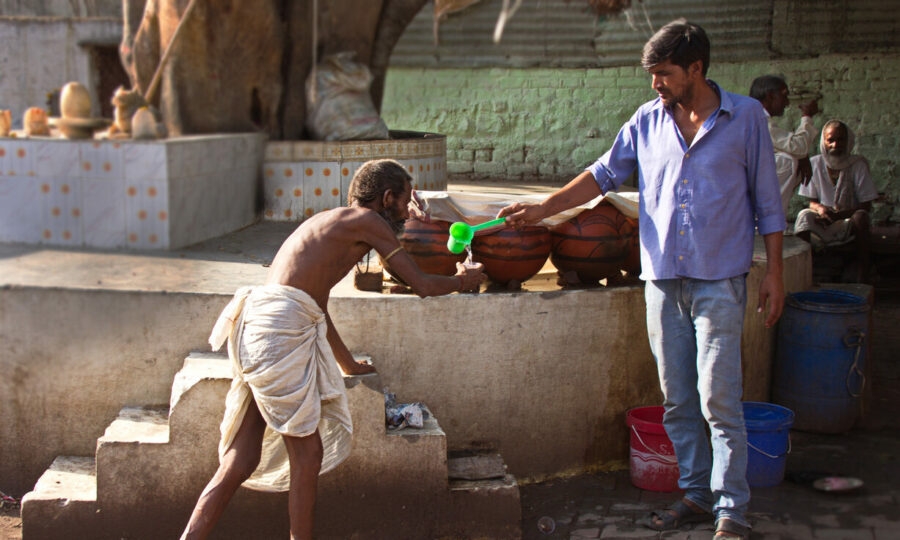Pagan Hindu Apartheid Still Infects the Church in India. Pope Francis Is Silent

An upper caste man serving water to a Dalit keeps his distance to avoid "contamination" by contact.
Let’s step in a time machine, to go back to India at any point before 1950. Imagine you’re there, and you’re thinking of converting to Catholicism. You’re also from a low-caste or “untouchable” (Dalit) Hindu background. I would ask you to conduct a simple test.
Ask your pastor to introduce you to a Catholic priest from a Dalit background. He won’t and he can’t. Because, for centuries, the Catholic Church, following Hindu doctrine, refused to ordain “untouchables” to the priesthood.
The Fifth Provincial Council of Goa (1606) declared: “For the dignity of the priesthood and the respect due to the ecclesiastical persons, low castes should not be admitted to orders. Only sons of higher castes, for example Brahmins, Prabhus, should be ordained.”
No “Dirty” Christians Need Apply
If you were drawn to Catholicism because of the traditional Latin Mass and you wanted to study Latin to follow the liturgy more meaningfully, I would ask you to visit any seminary and check if you could study Latin as a Dalit.
The priest who came out to meet you at the seminary gate (if the watchman won’t shoo you away), would quote the Fifth Provincial Council, which states: “The Synod instructs rectors of seminaries not to teach Latin to non-Brahmins.”
The council was only following Catholic magisterial “tradition.” The Third Provincial Council of Goa in 1585 categorically stated: “Candidates for the priesthood should commonly be from the honored (high) and clean castes.”
Jim Crow Inside the Church, and Even the Graveyard
If you, my Hindu Dalit seeker-friend, had reconciled yourself to never becoming a priest, and would be content with remaining a lay Catholic, I’d have asked you to visit your parish church.
As a low-caste convert, you would almost certainly have to sit separately from high-caste Catholics during Mass (on the floor, at the back of the chapel or behind a wall), receive communion only after the upper castes, use a separate entrance to get into church, and be buried in a cemetery “FOR UNTOUCHABLES ONLY.”
Let alone the threat of polluting living upper caste Catholics sitting in the pews, you would have even risked polluting dead upper caste Catholics lying in the grave! I’m sorry you’d thought you could escape the caste system by fleeing Hinduism for Catholicism. Alas, much of the Ganges has flowed into the Tiber and polluted it with Hindu theology.
Pope Francis: No Human Dignity for YOU
I suggest you wait for a few centuries. A prophet tells me that a future pontiff is going to issue a declaration on human dignity. Pope Francis is sure to condemn the oldest, cruelest, and most racist institution in the history of religions — the caste system, no?
OK, now let me hop into my time machine and return to our brave new world.
On April 8, 2024, I rush to read Dignitas Infinita and find that despite the pleas of Dalit Catholics for decades, Pope Francis has not mentioned “caste” even once in his 12,000-word declaration condemning other forms of dehumanization like slavery, human trafficking, surrogacy, and abortion. Why such a glaring omission?
The Caste System: Worse than Apartheid
Let me explain. Westerners need to understand that the caste system is intrinsic to Hinduism and is rooted in the legal texts of the Manusmṛti, traditionally the most authoritative of the books of the Hindu code (Dharma-shastra).
This canonical corpus, attributed to Manu — the legendary first man and lawgiver — describes the untouchable as “polluted” and “unclean” from birth.
Please Support The Stream: Equipping Christians to Think Clearly About the Political, Economic, and Moral Issues of Our Day.
A hymn from the Purusasukta of the Hindu scripture, the Rig Veda, specifies four main castes or varnas. The highest caste Brahmin (priest) is born from god’s mouth, the Kshatriya (warrior) is born from the deity’s arm, the Vaishya (businessman or trader) comes from god’s belly, and the Shudra (menial) from the Creator’s feet.
The Dalit (untouchable) emerges from outside the Creator’s body, with no physical link to the Supreme Being. He is a different species, like an animal or sub-human. “Metaphorically and literally, the Dalit has been a ‘s–t bearer’ for three millennia, toiling at the very bottom of the Hindu caste hierarchy,” writes Prof. Sagarika Ghose.
My Hinduism professor in seminary used to tell us: “You can be a theist or an atheist; a monist or monotheist; a pantheist, panentheist, or polytheist; an iconodule or an iconoclast — any of the above — and be a Hindu. But you cannot be outside the caste system and remain a Hindu.”
The Vatican’s “Ecumenical” Enabling of Hindu Oppression
If Francis condemned caste — he’d be launching a nuclear attack on Hinduism. He cannot do this — not after Vatican II’s Nostra Aetate fawned over Hinduism as a religion by which “men contemplate the divine mystery and express it through an inexhaustible abundance of myths and through searching philosophical inquiry.”
Last year, the Vatican Dicastery for Interreligious Dialogue met Hindu leaders to discuss “building a ‘fraternity-based new humanism.’” According to Francis’s starry-eyed version of Hinduism, we are “Fratelli tutti” (all brothers), who need to preach the gospel of John Lennon and sing: “Imagine, there’s no caste. It’s easy if you try.”
Secondly, the Roman Church in India has sold its soul to inculturation, a euphemism for Hinduization. In 1969, the Vatican allowed Indian bishops to create a “New Order of the Mass for India.”
The rite, which is now ubiquitous in seminaries, convents, etc., uses explicit Hindu symbolism including the mantra “OM,” a Hinduized Eucharistic canon, and the Pavamana Abhyaroha (all-purifying holy chant) from the Brihadaranyaka Upanishad.
The liturgy uses the Brahmanical language of Sanskrit for litanies during the Mass, using explicitly Hindu names for God. Clergy even use Hindu scriptures as readings during the Mass.
The new Catholic liturgy in India uses the Brahmanical language of Sanskrit for litanies during the Mass, using explicitly Hindu names for God. Clergy even use Hindu scriptures as readings during the Mass.
While Hindus have attacked the Indian Rite Mass for “cultural appropriation,” Dalit Catholics have skewered it for adopting exclusively Brahmanical symbols, forms, and language, thus alienating them by perpetuating and glorifying the oppressive caste structures of Hinduism — which they thought they had escaped.
Thirdly, with glaring exceptions, the hierarchy has been dominated by high-caste clergy. In June 2022, for the first time in history, a Dalit — Archbishop Anthony Poola of Hyderabad, was made a cardinal by Pope Francis, an admirable decision.
Why anger Hindus and jeopardize dialogue? Why upset chic Catholic clerics who have jumped on the juggernaut of inculturation? Why annoy the Indian hierarchy who are sucking-up big-time to the Hindu supremacist regime led by Prime Minister Narendra Modi? Better to kick the Dalits and omit any reference to caste in Dignitas Infinita.
Centuries of Scorn
I am truly sorry for you, my Dalit friend seeking to convert to Catholicism. I know you feel terribly hurt because after centuries your concerns on human dignity have not been addressed even by the most “progressive” pontiff in Catholic history.
Perhaps this is because “from the beginning of the modern missionary movement in India, starting with the arrival of the Portuguese in 1448, the Catholic Church tried to conform more to the prevailing caste-system in India than to condemn it,” as Fr. Vijaya Joji Babu Valle notes in his doctoral thesis.
“The Church, in a sense, preferred the conversions from upper castes to the conversion of lower castes,” Fr. Valle observes, citing my peer-reviewed journal article, “Portuguese Mission in Goa: Conflict and Collaboration Between Colonial and Brahmanical Power.” (I write about caste with a certain sense of shame, coming as I do from the highest caste, which created this oppressive system.)
Protestants Did Better
At first, Protestant missionaries also conformed to Hindu caste structures “but such preferential and discriminative trends changed in the later Protestant missions,” Fr. Valle shows. “The missionary movement directed towards the conversion of Dalits in India was chiefly initiated by Protestant Churches.”
Anglican Bishop Wilson Samuel of Calcutta demanded that converts renounce caste before baptism and confirmation. The American Madura Mission (Congregationalist) required upper-caste converts to drink tea with a Dalit. The Protestant Missionary Conferences of 1858, 1879, 1900 condemned the caste system.
The 1958 conference declared: “No man should be regarded as worthy of the name of Christian who refuses to renounce caste and to remove all its outward marks.”
Contrast this with the Tamil Nadu Jesuits, who for all their social justice wokery, actually split along caste lines, leaving the Madurai province to form a new Chennai province as recent as 2019.
Protestant churches, particularly in South India, are also infested with the contagion of caste. But they never enshrined it in their official legislation, as Catholics did for centuries.
Dr. Jules Gomes, (BA, BD, MTh, PhD), has a doctorate in biblical studies from the University of Cambridge. Currently a Vatican-accredited journalist based in Rome, he is the author of five books and several academic articles. Gomes lectured at Catholic and Protestant seminaries and universities and was canon theologian and artistic director at Liverpool Cathedral.


